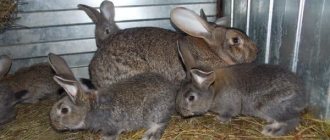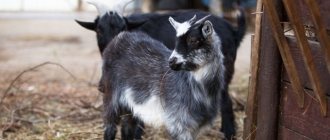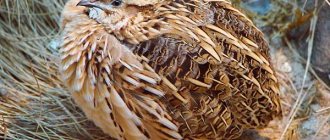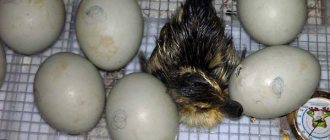To provide rabbits with a comfortable existence that is as close as possible to natural conditions, modern farmers are increasingly resorting to the method of breeding rabbits in pits. It is no secret that domesticated animals become weaker compared to their wild relatives. Animals kept in cages react poorly to changes in temperature and humidity, and their immunity approaches zero.
Recently, many rabbit breeders are moving away from cage farming and using the pit method of keeping animals.
Technology for raising rabbits in pits
To move into the rabbitry, a female and a male are selected from different litters in order to exclude the development of genetic diseases and degeneration of the species. Sick animals are removed in a timely manner, preventing the spread of infection and death of the herd.
For breeding in pits, choose 1-2 medium-sized breeds:
- Viennese blue. Rabbits have high-quality fur, a standard weight of up to 4.5 kg, and can withstand adverse climatic conditions.
- Butterfly. Representatives of the breed adapt well to the weather.
- Californian. The average weight of the animals is 4.5 kg. They love warmth, it is better to move them to a barn for the winter.
- New Zealand. Rabbits weigh up to 4.5 kg and prefer to live in warmth. In winter, individuals are transferred indoors.
- Rex. Animal weight up to 4 kg. Able to live in a hole all year round. Suitable temperature for keeping: +15 °C.
The farm owner's responsibilities include:
- providing food twice a day;
- cleaning the pit and replacing hay once every three weeks;
- adding clean water;
- identification and capture of sick animals.
Photo gallery of keeping rabbits in pits:
Advice from experienced farmers
If you are planning to seriously engage in this business, then you should read some advice from professionals. They apply to anyone who wants to keep rabbits for more than 1 season in a pit. Let's take a closer look.
- It is necessary to treat them with antibiotics before planting them in the pit, and also to pierce all females to avoid the spread of infection among future young animals.
- Immediately teach the animals that the owner gives food, feed them in the middle of the room, and be present at meals at least sometimes. If this is not done, you will have serious problems when you want a hat or meat - you will not be able to catch game, you will chase them endlessly.
- Make a good roof over the main pit, since in a heavy rain it can flood, and some offspring may drown in holes located below floor level. As a rule, animals dig them slightly upward in case of rain - this is a natural instinct, but it can fail domestic rabbits.
- Concrete or cover a large area of the main room with bricks, since after a few months it will begin to crumble and you will have to carry out repair work. This will give you a lot of inconvenience. Wooden walls can be “tied up”. We take an electric drill, drill a 16 mm hole, drive in a large anchor with good plastic spacers. For clay soil this will be enough. The main thing is to place a large washer so that it does not push through the wooden boards.
If done correctly, your rabbits will not bother you at all. You will come to them once every 2-3 days to pour food into the feeder in the middle of the room or give them some greens. Nothing more is required.
Pros and cons of raising rabbits in pits
In addition to reducing equipment costs, the obvious advantages of the method include:
- stimulation of motor activity of rabbits;
- no need for large areas for a farm;
- strengthening the immunity of animals, resistance to diseases;
- absence of drafts;
- reduction of time costs and physical effort of the owner;
- extraction of useful substances by animals directly from the soil;
- acceleration of reproduction;
- the birth and nursing of offspring does not require intervention, the female copes independently;
- reducing the volume of feed consumed;
- improving the taste of rabbit meat.
With all the advantages of the method, there are also disadvantages:
- mating within a population leading to degeneration;
- nutrition is difficult to control;
- wild rabbits;
- damage to skins in fights;
- competition between same-sex individuals;
- growing large breeds is not suitable for the conditions;
- spread of infections in the population;
- Isolation of sick animals is difficult.
Advantages of the method
Amateur rabbit breeders consider the following points to be the positive aspects of this method.
- Low investment and labor costs for arranging a home for rabbits.
- Possibility to place a large number of livestock (200 individuals) in a small area (4 square meters).
- Increased immunity due to the high physical activity of animals. They become less susceptible to infections.
- Always the same temperature, comfortable for rabbits. At twelve to fifteen degrees. This means they will be cool in the summer and warm in the winter.
- Complete absence of drafts, which are the main provocateurs of colds.
- Increased sexual activity, leading to rapid reproduction.
- Childbirth in females is easier, since it is closer to natural conditions. Human intervention in this process is not required; on the contrary, it can cause additional stress due to the increased fearfulness of rabbits.
- Living together in a herd helps them fight rats and other pests.
In the hole there is always a constant temperature that is comfortable for rabbits.
According to some rabbit breeders, keeping animals freely improves the taste of their meat. And this is why rabbits are bred.
Choosing a place to start
The pit is set up in a shady place on a hill to prevent flooding with groundwater and direct sunlight.
The correct option for building a rabbitry is clay soil; on sandy soils, additional reinforcement of the walls will be needed to prevent crumbling.
Rocks are unsuitable for construction; the presence of underground sources leads to flooding of burrows. If rabbits reach water while digging shelters, they will change direction and bring the tunnel to the surface, leading to escape.
In the absence of suitable conditions, rabbits can be raised in the basement or cellar of the house.
ATTENTION !
This article reveals only one of the methods of breeding rabbits.
To complete the picture, I suggest you familiarize yourself with alternative management options. Perhaps one of them will suit you better. ✨ Professor Mikhailov’s methodology, accelerators and cells intended for them. ✨ The minifarm is a real complex for living and servicing rabbits. ✨ What to do if you only have improvised means at hand, but there are not enough cells. ✨ Multi-tiered cellular structures to save space. ✨ Salov cages for indoor use.
Arrangement of the pit
The detailed drawing includes the underground part, ground protective fencing, canopy, corner posts, air ducts, lighting. The construction technology is simple, but requires some physical effort. Excavation work is limited to digging a hole measuring 2x2 m to a depth of 1.5 m. Rabbits multiply quickly, taking into account the speed of reproduction, the length is increased to 3 m. A dwelling of such an area can accommodate 100-200 individuals. The pits are placed near country houses, ensuring constant surveillance.
To reduce the spread of odor, the bottom is covered with sand to a depth of 20 cm, and the top is covered with a fine-mesh mesh. Hay is thrown over the grate, and the litter is renewed as it gets dirty. For the walls they use slate, which is too tough for rabbits, or other available material. Three walls are closed, leaving free space for holes in the fourth. Feeders and drinkers are placed in sufficient quantities along one wall. The entrance to the hole is marked at a height of 15-20 cm above ground level, digging a little downward or straight so that the animals understand where to dig.
Protection from predators is provided by the lattice cover, which provides an influx of fresh air.
You need to make a canopy on top, tilted in the direction opposite to the entrance. At the construction stage, it is necessary to provide for the installation of a ventilation system. To do this, install a pipe, leading one end to the street, the other under the roof. Rabbits need lighting to navigate space and time of day. In complete darkness, their vision deteriorates, so when arranging the roof, they add sliding structures or install electric lamps.
The place of residence is surrounded by a fence, because if you dig in the wrong direction, the hole will come to the surface and the animals will get out of the shelter. The length of the burrow reaches 20 m and can go both inside and outside the fenced area. To prevent a mass escape and to detect wounded or sick animals in time, burrows are regularly checked. Rabbits benefit from outdoor walks and a fenced-in area with a lawn for walking. Exit to the street is equipped with a door with a latch.
Peculiarities of settlement and training for digging
It is recommended to introduce several individuals familiar with the living conditions into the new dugout. Adult rabbits, accustomed to living in cages, have a hard time with changing their place of residence and take a long time to adapt. Young animals aged 4-5 months are selected for settlement at the rate of 6 females per male. The first batch is vaccinated against diseases, young rabbits are given prophylaxis with antibiotics, and the following animals are added in batches of 10.
The peculiarity of the placement leads to situations where rabbits refuse to dig holes; this happens due to loss of instinct. The problem is solved by introducing animals that previously lived in pits as role models. If there are none, dig a hole 50 cm deep with a shovel, simulating the entrance to a hole, pointing it down at a slight angle.
To form a hole, a log with a diameter of 20 cm is inserted into the hole, the free space is filled with earth and compacted, then the tree is removed. Subsequently, the females continue to dig on their own, increasing the usable area, gradually turning the hole into a “multi-apartment” dwelling.
Construction of holes
As a result of domestication, many rabbits have lost their natural desire to dig holes. Therefore, breeders often have to help animals by creating a hole with their own hands. This method is a real opportunity to awaken the nesting instinct.
Some animals, following their instincts, dig holes on their own
The length of the hole is made as long as possible, and the width is such that two or three adults can climb in at the same time (entrance diameter 40-45 cm). The height of the hole above the floor level should be approximately 20 cm, and the passage itself should have a downward slope of 20-30 degrees. The entrance is strengthened with a log with a diameter of at least 20 cm. It is inserted into the hole blank, the spaces on top and on the sides are carefully compacted with earth and clay. Then the log is removed and the entrance is widened, making it cone-shaped.
Profile of an artificial burrow for young animals
Profile of an artificial burrow for a female (nesting)
Animals first sniff and explore artificial burrows, and then begin to actively explore them.
Possible problems
When kept in pits, rabbits run wild and problems arise with catching. To resolve the issue, the entrance to the hole is equipped with a lattice door with a latch.
To catch the animals, they are taught to go out to feed at the sound of a sound signal, caught by the ears or with a net.
If you neglect to regularly remove garbage, rats may appear in the pits. Rodents bite rabbits and carry infectious diseases; installing a fence will help protect against unwanted intrusions.
Reproduction in pits
The pit method makes birth control impossible; females are constantly pregnant. When kept in a burrow, recovery after birth is faster; females do not distinguish between their own or someone else’s offspring, so they feed everyone.
Experienced rabbit breeders recommend monitoring female rabbits that have given birth. Restlessness and rapid weight loss indicate that the newborns were eaten or strangled, and the lack of drinking water also leads to the destruction of the rabbits.
Sire males are regularly changed to prevent deterioration in the quality of the breed and inbreeding. Females that do not meet breed standards are also removed. As the population grows, young rabbits are placed in another pit.
Raising animals provides a source of regular income, but the skins of rabbits raised in pits are not suitable for sale. However, meat is in constant demand, and the production method ensures low cost and accessibility for beginners.
Choosing a breed
There are certain requirements for the breed of rabbits itself, which is planned to be raised in a pit. You should immediately abandon hybrids and other complex lines that require increased attention from the breeder. The best option is a domestic breed, adapted to living in certain climatic conditions.
If you try to create a rating of the most suitable breeds for the pit method of cultivation, then the Rex and the Burgundy rabbit will be included in its table of contents. They are resistant to sub-zero temperatures and have good immunity.
The description of the Soviet chinchilla breed also indicates the adaptability of its representatives to negative temperatures, but given the large dimensions of adult individuals, you should not opt for this line.
You can seek advice from more experienced breeders who live in your region and practice this method of breeding rabbits. Those farmers who have encountered pits in their own practice will definitely be able to share useful information.











